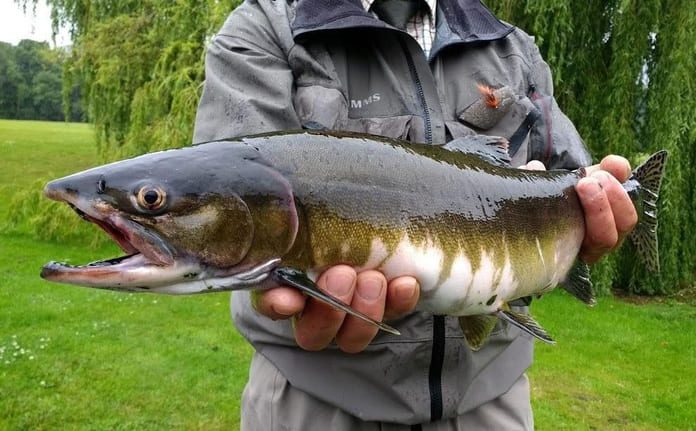Pacific salmon a threat to already fragile wild Atlantic populations.
The UK Environment Agency (EA) is urging anglers to report unusual catches or sightings of invasive pink salmon after unprecedented numbers have been detected further south than previously observed.
The salmon have already been caught this year in the Ness in the Highlands.
Pink salmon, which can be identified by large black oval spots on its tail, could carry diseases which threaten native fish stocks.
EA specialists have predicted that the fish (also known as humpback salmon), will be spotted in North East and North West rivers over the coming weeks.
“Wild Atlantic salmon stocks are already under great pressure from a variety of sources,” said Simon Toms, National Fisheries Management Team Leader at the EA.
“The introduction of novel parasites or diseases from invasive species, such as Pacific pink salmon, could represent an additional risk to the species.”
Soviet experiment
Pink salmon (Onchorhyncus gorbuscha) originate from the northern Pacific Ocean. Following an initiative to develop a net fishery in Northern Russia by Soviet scientists, the species was successfully introduced to rivers draining into the White Sea in 1959.
Since then, the fish have been observed in variable numbers in Norwegian waters, and have now established self-sustaining populations in rivers in Russia, Finland and Northern Norway.
In 2017, pink salmon were also caught in rivers in the UK and Ireland, in countries in mainland western Europe, as well as in Iceland and on the east coast of Canada.

Rivers across northern Europe already under threat
Increased recent sightings of pink salmon in the UK this year follow reports from Norway earlier this summer where an influx of the unwanted fish have forced locals to take measures to prevent the pink salmon’s takeover. According to the local Fishing and Hunting Association in Sør-Varanger, traps in one of the local rivers in the course of only nine days caught as many a 2,700 pink salmon.
The Norwegian Environment Agency has proposed the establishing of a national competence group for combating humpback salmon to make regional plans for the eradication of the fish, coordination of measures and supervision of the removal of invasive species from individual rivers across the country.
In both 2017 and 2019, rivers in Finnmark province in the north of Norway recorded their highest ever numbers of spawning humpback salmon. With the fish tending to spawn en masse every other year, some are predicting this may be the worst year yet.
“The biggest intrusion of humpback salmon occurs in the rivers in Eastern Finnmark, so this is where it is most important to direct the effort. If we manage to fish out most of the humpback salmon in this area, we will establish a buffer zone against humpback salmon from Russia. This will be an important measure to prevent further spread of humpback salmon to the west and south of Norway,” said Ellen Hambro, director of the Norwegian Environment Agency.
Vigilant
In the UK, previously, pink salmon have been caught in the River Tyne at Wylam and in other locations across Cornwall, Wales, Scotland and western Ireland. Examinations revealed that no notable disease or novel parasites were detected. However, the Environment Agency has stressed the need to remain watchful and will continue to investigate the possible risk posed by pink salmon.
Data collected will help the Environment Agency and fisheries researchers better understand how to manage the arrival of pink salmon in the UK.


